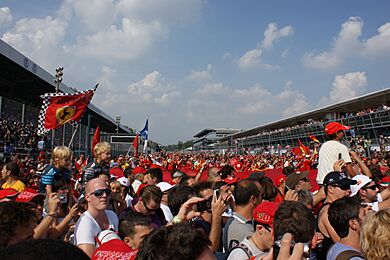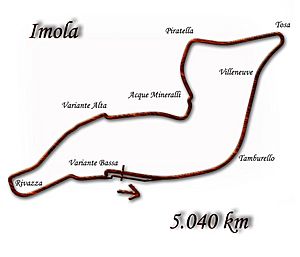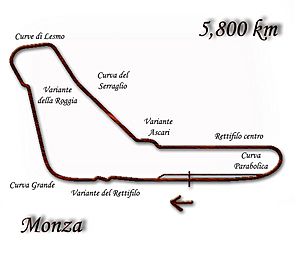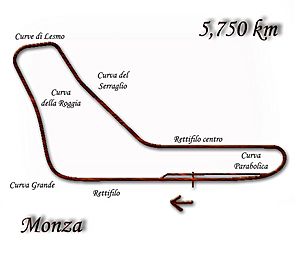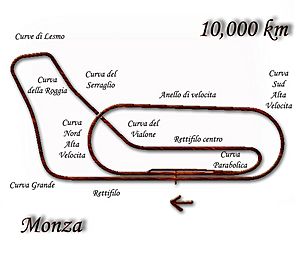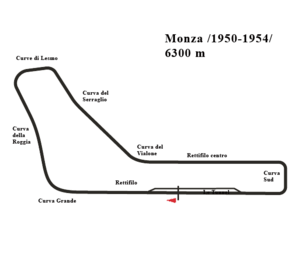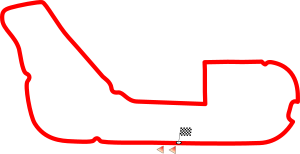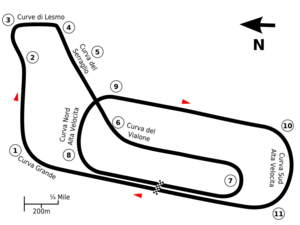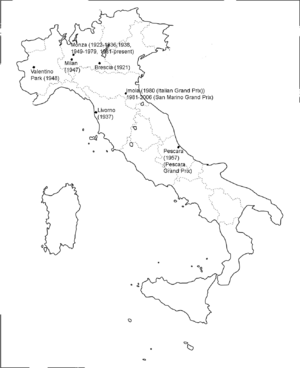Italian Grand Prix facts for kids
| Autodromo Nazionale di Monza (1922–1979; 1981–present) |
|
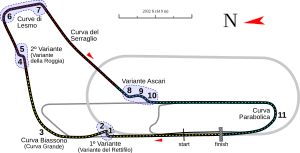 |
|
| Race information | |
|---|---|
| Number of times held | 94 |
| First held | 1921 |
| Most wins (drivers) | |
| Most wins (constructors) | |
| Circuit length | 5.793 km (3.600 mi) |
| Race length | 306.720 km (190.596 mi) |
| Laps | 53 |
| Last race (2024) | |
| Pole position | |
|
|
| Podium | |
|
|
| Fastest lap | |
|
|
The Italian Grand Prix (which means Gran Premio d'Italia in Italian) is one of the oldest and most famous motor racing events in the world. It has been held almost every year since 1921. As of 2024, it has been run 94 times, making it the Grand Prix held most often.
Since the Formula One World Championship began in 1950, the Italian Grand Prix has been part of every season. This makes it one of only two races (the other being the British Grand Prix) to have this record. Most of these races have taken place at the Monza circuit in Italy. Only in 1980 was the race held at a different track, Imola.
Before Formula One started, the Italian Grand Prix was also an important race for other championships. It was sometimes called the European Grand Prix, which was an honorary title given to a major race in Europe each year. A few early races were held in different Italian cities like Montichiari, Livorno, Milan, and Turin. The race is planned to stay at the Monza Circuit until at least 2031.
History of the Italian Grand Prix
How the Race Started
The very first Italian Grand Prix happened on September 4, 1921. It was held on a long 17.3-kilometer (10.7-mile) track near Montichiari. However, the race is much more famous for being held at the Monza circuit. Monza is a special racing facility located just outside Milan, a big city in northern Italy.
The Monza track was built in 1922, just in time for that year's race. It is located in a public park called Parco di Monza, which is mostly woodland. The famous Royal Villa of Monza is also in this park.
Monza Circuit: A Fast Track

The Autodromo Nazionale di Monza was finished in 1922. It was only the third permanent race track in the world at that time. The other two were Brooklands in England and Indianapolis in the United States. Famous racing pioneers Vincenzo Lancia and Felice Nazzaro even helped build it.
The original Monza track was 10 kilometers (6.25 miles) long. It had a flat, banked section and a regular road circuit combined. This made it very fast and exciting. The 1923 race even featured a rare appearance by an American car, the "American Miller 122," driven by Louis Zborowski. Sadly, Zborowski died at Monza the next year.
The 1928 race was a very sad day for Monza. A terrible accident happened where a car crashed into the stands, causing many deaths and injuries. This was one of the worst accidents in motor racing history at the time. Because of this, the Italian Grand Prix was not held for three years.
When the race returned in 1931, it was a long endurance race, lasting ten hours. Giuseppe Campari and Tazio Nuvolari shared the win in an Alfa Romeo. Nuvolari won again in the shorter 1932 race.
A Very Sad Day in 1933
In 1933, another very sad event happened at Monza. It became known as the "Black Day of Monza." During a race, there was an oil patch on the track. Two drivers, Giuseppe Campari and Baconin Borzacchini, were racing very closely. Both of them crashed in separate incidents at the same spot. Sadly, both drivers lost their lives.
Later that day, another driver, Stanislas Czaykowski, also crashed and died when his car caught fire. These tragedies showed how incredibly dangerous motor racing was in those days. There were almost no safety features. Spectators often stood very close to the track with no protection.
These events deeply affected people like Enzo Ferrari, who was close to some of the drivers. Racing historians say this day changed motor racing forever. It marked the end of a more carefree era and the start of a time when people began to think more seriously about safety.
Different Tracks and Monza's Return
After the terrible 1933 race, changes were made to Monza. Shorter versions of the track were used, with chicanes (slow corners) added to make it safer. German teams like Mercedes and Auto Union dominated these races. In 1937, the Italian Grand Prix was even held on a street circuit in Livorno.
The race returned to Monza in 1938, but then World War II started, and the Grand Prix was not held again until 1947.
In 1947, the race was held in Milan, but another accident occurred, injuring spectators. This track was never used again. In 1948, the race moved to Turin. Finally, in 1949, the Italian Grand Prix returned to Monza, where it stayed for the next 30 years.
Monza's Changes and Exciting Races (1949–1979)
When racing returned to Monza, the track was changed. The old banked sections were no longer used for Formula One. A new corner called the Parabolica was built.
The 1950 race was special because it was part of the very first Formula One World Championship. Giuseppe Farina won that race and became the first F1 World Champion. Many famous drivers like Alberto Ascari, Juan Manuel Fangio, and Stirling Moss won at Monza in the 1950s.
After 1954, Monza was completely rebuilt. New facilities were added, and a new, very steep banked section was built. This combined track was incredibly fast. In 1955, F1 cars were averaging over 217 km/h (135 mph) per lap!
In 1960, the British teams boycotted the race because they felt the banked section was too dangerous for their cars. This meant Ferrari had no real competition, and American driver Phil Hill won. This was the last time a front-engined F1 car won a race.
The 1961 race was another tragic day. Two Ferrari drivers, Phil Hill and Wolfgang von Trips, were fighting for the championship. During the race, von Trips crashed and was killed, along with 14 spectators. Phil Hill won the race and the championship.
After this, the banked section was never used again for Formula One races. The track continued to be used, but only the road circuit. Many great drivers won at Monza in the 1960s and 70s, including Graham Hill, Jim Clark, John Surtees, and Jackie Stewart.
The 1971 was one of the closest finishes in F1 history. Five cars were battling for the lead on the last lap, and Peter Gethin won by just one-hundredth of a second!
To make the track safer and slow the cars down, chicanes were added in 1972 and 1974. The Vialone curve was even renamed Variante Ascari, after Alberto Ascari, who died there in a testing accident in 1955.
The 1975 was a big moment for Ferrari. Their driver Niki Lauda won his first world championship at Monza, and Ferrari also won the Constructors' Championship.
In 1978, another very sad accident happened at the start of the race. Ronnie Peterson was involved in a multi-car crash and later died from his injuries. This led to more discussions about improving safety in Formula One. Despite the tragedy, Niki Lauda won the shortened race.
In 1979, Monza was upgraded with more runoff areas (safe zones) and other improvements. Jody Scheckter won the race for Ferrari and also secured his world championship.
Imola in 1980 and Monza's Modern Era
In 1980, the Italian Grand Prix was held at the Imola circuit while Monza underwent major upgrades, including a new pit complex. Brazilian driver Nelson Piquet won that race. The Imola circuit later became home to the San Marino Grand Prix from 1981 to 2006.
The Italian Grand Prix returned to Monza in 1981 and has been held there ever since. Many legendary drivers have won at Monza in the modern era, including Alain Prost, Ayrton Senna, Nigel Mansell, and Damon Hill.
After some tragic accidents in 1994 at Imola, more safety changes were made to Monza in 1995. Corners like Curva Grande and Lesmo were slowed down, and wider runoff areas were created.
In 2000, further changes were made to the track layout. Sadly, during the start of the race that year, a marshal was hit by a loose wheel from a car and died from his injuries. This led to even stricter safety rules for marshals and spectators.
Despite the sad moments, Monza has seen many triumphs. Michael Schumacher won many times for Ferrari in the 2000s. In 2008, Sebastian Vettel became the youngest driver ever to win a Formula One Grand Prix at Monza, at just 21 years old. He also became the youngest to get pole position and finish on the podium.
In 2020, Lewis Hamilton set the fastest ever qualifying lap in Formula One history at Monza, with an average speed of 264.362 km/h (164.267 mph).
Many Italian drivers have won the Italian Grand Prix over the years, but none since Ludovico Scarfiotti in 1966. Michael Schumacher and Lewis Hamilton hold the record for most wins by a driver, with five victories each. Ferrari has won their home race 21 times, most recently with Charles Leclerc in 2024.
The 2023 Italian Grand Prix was the shortest race ever in terms of time, not counting races that were stopped early. It lasted just 1 hour, 13 minutes, and 41 seconds.
Winners
Drivers with Multiple Wins
Drivers in bold are currently competing in Formula One. A pink background means the race was not part of the Formula One World Championship. A yellow background means the race was part of the pre-war European Championship.

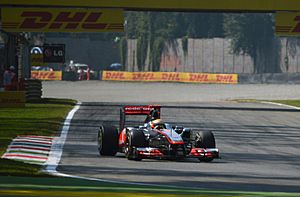
| Wins | Driver | Years won |
|---|---|---|
| 5 | 1996, 1998, 2000, 2003, 2006 | |
| 2012, 2014, 2015, 2017, 2018 | ||
| 4 | 1980, 1983, 1986, 1987 | |
| 3 | 1931, 1932, 1938 | |
| 1949, 1951, 1952 | ||
| 1953, 1954, 1955 | ||
| 1956, 1957, 1959 | ||
| 1973, 1974, 1976 | ||
| 1981, 1985, 1989 | ||
| 2002, 2004, 2009 | ||
| 2008, 2011, 2013 | ||
| 2 | 1933, 1934 | |
| 1934, 1937 | ||
| 1960, 1961 | ||
| 1964, 1967 | ||
| 1965, 1969 | ||
| 1970, 1975 | ||
| 1978, 1984 | ||
| 1990, 1992 | ||
| 1993, 1994 | ||
| 2001, 2005 | ||
| 2007, 2010 | ||
| 2019, 2024 | ||
| 2022, 2023 | ||
| Sources: | ||
Winning Teams (Constructors)
Teams in bold are currently competing in Formula One. A pink background means the race was not part of any championship. A yellow background means the race was part of the pre-war European Grand Prix Championship. A green background means the race was part of the pre-war World Manufacturers' Championship.
| Wins | Constructor | Years won |
|---|---|---|
| 21 | 1949, 1951, 1952, 1960, 1961, 1964, 1966, 1970, 1975, 1979, 1988, 1996, 1998, 2000, 2002, 2003, 2004, 2006, 2010, 2019, 2024 | |
| 11 | 1968, 1984, 1985, 1989, 1990, 1992, 1997, 2005, 2007, 2012, 2021 | |
| 9 | 1934, 1937, 1954, 1955, 2014, 2015, 2016, 2017, 2018 | |
| 8 | 1924, 1925, 1931, 1932, 1933, 1947, 1948, 1950 | |
| 6 | 1986, 1987, 1991, 1993, 1994, 2001 | |
| 5 | 1963, 1972, 1973, 1974, 1977 | |
| 4 | 2011, 2013, 2022, 2023 | |
| 3 | 1935, 1936, 1938 | |
| 1962, 1965, 1971 | ||
| 1978, 1980, 1983 | ||
| 2 | 1922, 1923 | |
| 1926, 1928 | ||
| 1953, 1956 | ||
| 1957, 1958 | ||
| 1981, 1982 | ||
| Sources: | ||
Winning Engine Manufacturers
Manufacturers in bold are currently competing in Formula One. A pink background means the race was not part of any championship. A yellow background means the race was part of the pre-war European Grand Prix Championship. A green background means the race was part of the pre-war World Manufacturers' Championship.
| Wins | Manufacturer | Years won |
|---|---|---|
| 22 | 1949, 1951, 1952, 1960, 1961, 1964, 1966, 1970, 1975, 1979, 1988, 1996, 1998, 2000, 2002, 2003, 2004, 2006, 2008, 2010, 2019, 2024 | |
| 15 | 1934, 1937, 1954, 1955, 1997, 2005, 2007, 2009, 2012, 2014, 2015, 2016, 2017, 2018, 2021 | |
| 9 | 1924, 1925, 1931, 1932, 1933, 1947, 1948, 1950, 1978 | |
| 8 | 1968, 1969, 1972, 1973, 1974, 1976, 1977, 1980 | |
| 1981, 1982, 1991, 1993, 1994, 1995, 2011, 2013 | ||
| 7 | 1967, 1986, 1987, 1989, 1990, 1992, 2020 | |
| 3 | 1935, 1936, 1938 | |
| 1962, 1965, 1971 | ||
| 2 | 1922, 1923 | |
| 1926, 1928 | ||
| 1953, 1956 | ||
| 1957, 1958 | ||
| 1959, 1963 | ||
| 1984, 1985 | ||
| 1983, 2001 | ||
| Sources: | ||
* Between 1997 and 2005 built by Ilmor, funded by Mercedes
** Built by Cosworth, funded by Ford
*** Built by Porsche
Winners by Year
A pink background means the race was not part of any championship. A yellow background means the race was part of the pre-war European Championship. A green background means the race was part of the pre-war World Manufacturers' Championship.
See also
 In Spanish: Gran Premio de Italia para niños
In Spanish: Gran Premio de Italia para niños




